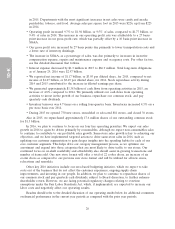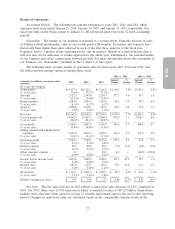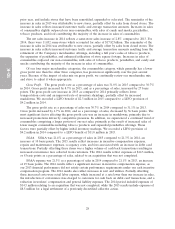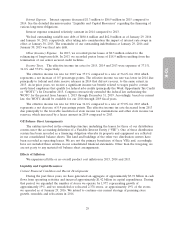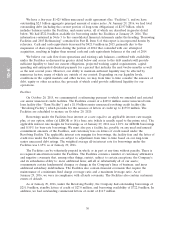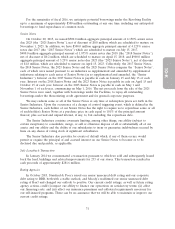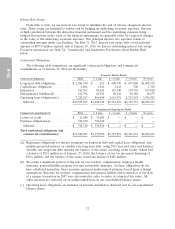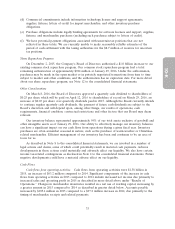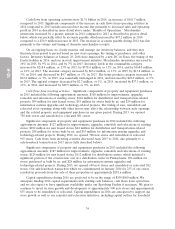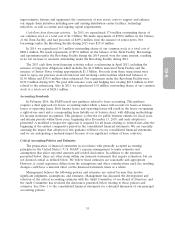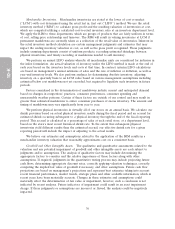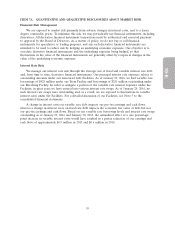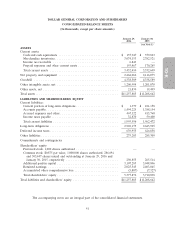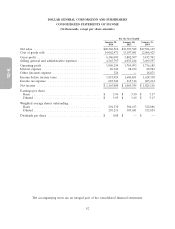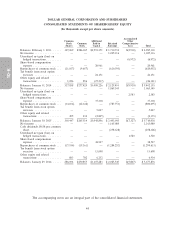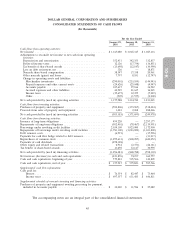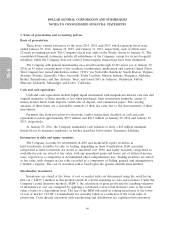Dollar General 2015 Annual Report Download - page 110
Download and view the complete annual report
Please find page 110 of the 2015 Dollar General annual report below. You can navigate through the pages in the report by either clicking on the pages listed below, or by using the keyword search tool below to find specific information within the annual report.
10-K
Merchandise Inventories. Merchandise inventories are stated at the lower of cost or market
(‘‘LCM’’) with cost determined using the retail last in, first out (‘‘LIFO’’) method. We use the retail
inventory method (‘‘RIM’’) to calculate gross profit and the resulting valuation of inventories at cost,
which are computed utilizing a calculated cost-to-retail inventory ratio at an inventory department level.
We apply the RIM to these departments, which are groups of products that are fairly uniform in terms
of cost, selling price relationship and turnover. The RIM will result in valuing inventories at LCM if
permanent markdowns are currently taken as a reduction of the retail value of inventories. Inherent in
the retail inventory method calculation are certain management judgments and estimates that may
impact the ending inventory valuation at cost, as well as the gross profit recognized. These judgments
include ensuring departments consist of uniform products, recording estimated shrinkage between
physical inventories, and timely recording of markdowns needed to sell inventory.
We perform an annual LIFO analysis whereby all merchandise units are considered for inclusion in
the index formulation. An actual valuation of inventory under the LIFO method is made at the end of
each year based on the inventory levels and costs at that time. In contrast, interim LIFO calculations
are based on management’s annual estimates of sales and the rate of inflation or deflation, as well as
year-end inventory levels. We also perform analyses for determining obsolete inventory, adjusting
inventory on a quarterly basis to an LCM value based on various management assumptions including
estimated below cost markdowns not yet recorded, but required to liquidate such inventory in future
periods.
Factors considered in the determination of markdowns include current and anticipated demand
based on changes in competitors’ practices, consumer preferences, consumer spending and
unseasonable weather patterns. Certain of these factors are outside of our control and may result in
greater than estimated markdowns to entice consumer purchases of excess inventory. The amount and
timing of markdowns may vary significantly from year to year.
We perform physical inventories in virtually all of our stores on an annual basis. We calculate our
shrink provision based on actual physical inventory results during the fiscal period and an accrual for
estimated shrink occurring subsequent to a physical inventory through the end of the fiscal reporting
period. This accrual is calculated as a percentage of sales at each retail store, at a department level,
based on the store’s most recent historical shrink rate. To the extent that subsequent physical
inventories yield different results than the estimated accrual, our effective shrink rate for a given
reporting period will include the impact of adjusting to the actual results.
We believe our estimates and assumptions related to the application of the RIM results in a
merchandise inventory valuation that reasonably approximates cost on a consistent basis.
Goodwill and Other Intangible Assets. The qualitative and quantitative assessments related to the
valuation and any potential impairment of goodwill and other intangible assets are each subject to
judgments and/or assumptions. The analysis of qualitative factors may include determining the
appropriate factors to consider and the relative importance of those factors along with other
assumptions. If required, judgments in the quantitative testing process may include projecting future
cash flows, determining appropriate discount rates, correctly applying valuation techniques, correctly
computing the implied fair value of goodwill if necessary, and other assumptions. Future cash flow
projections are based on management’s projections and represent best estimates taking into account
recent financial performance, market trends, strategic plans and other available information, which in
recent years have been materially accurate. Changes in these estimates and assumptions could
materially affect the determination of fair value or impairment, however, such a conclusion is not
indicated by recent analyses. Future indicators of impairment could result in an asset impairment
charge. If these judgments or assumptions are incorrect or flawed, the analysis could be negatively
impacted.
36


